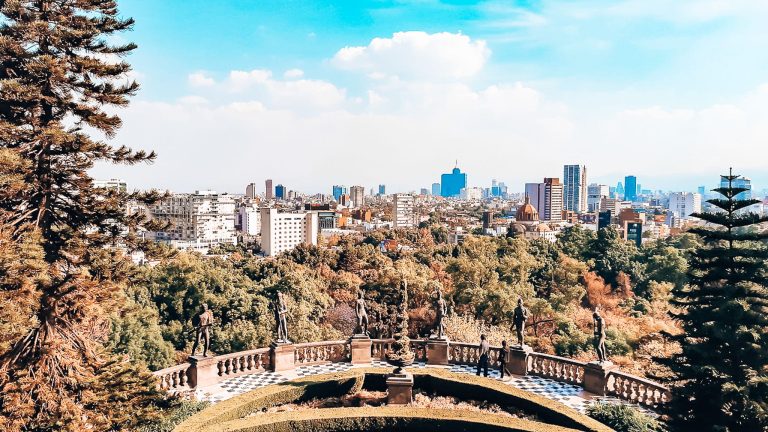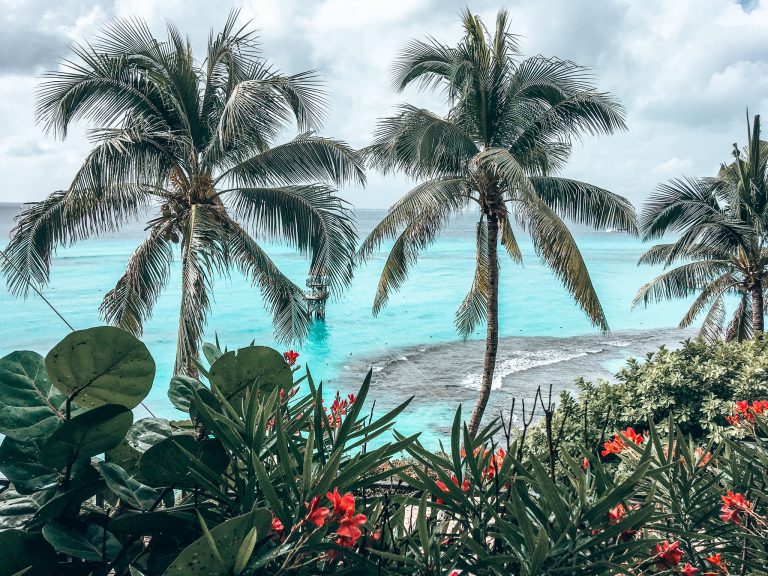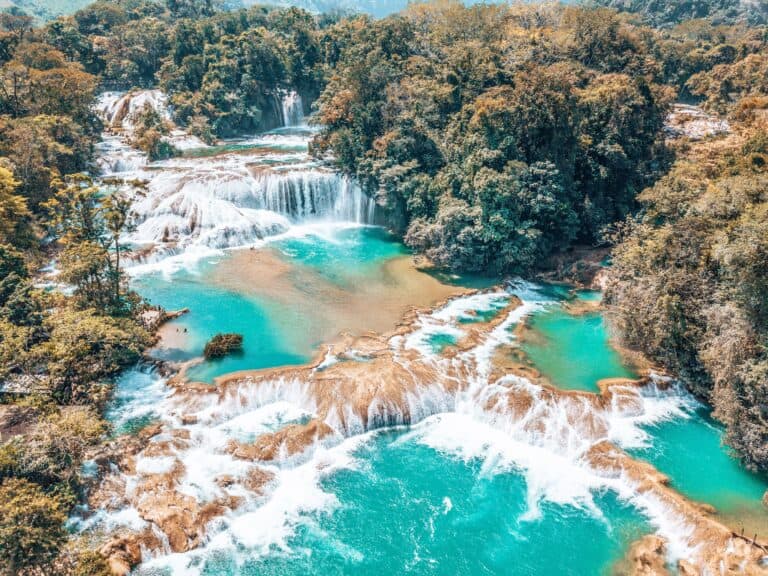
A Remarkable 3-Week Mexico Itinerary
Vibrant streets bursting with life and colour, breathtaking cenotes deep in the jungle, spectacular ancient ruins, quaint colonial towns, postcard-perfect beaches, incredible food and dramatic mountain vistas are just a few of the things you’ll experience on your 3-week Mexico itinerary. Read on for more and everything you need to know before you go.
Mexico has it all and is a treat for all your senses! It’s vibrant, colourful and packed full of history and culture. Pristine beaches stretch as far as the eye can see, the smell of sizzling tacos wafts from street corners, and the sound of mariachi bands drifts through cobbled streets while you’re sipping on a cold drink.
Look for adventure? Mexico has you covered – hike in mystical cloud forests, snorkel amongst colourful corals and tropical fish, swim in cascading waterfalls and natural sinkholes deep in the jungle.
If you prefer history, you can explore ancient ruins dating back to Mesoamerican civilisations that have been beautifully preserved, or sit in wide, opulent plazas left behind by the Spanish in colourful colonial towns.
Or, if you’re craving rest and relaxation on your 3 weeks in Mexico, you can have that too. Endless white-sand beaches nestled amongst lush mangrove forests and turquoise ocean are perfect for those quieter days.

With a 3-week Mexico itinerary, you can experience a bit of everything. This guide is for the curious who want to dig deeper than the resorts and truly experience what Mexico is about. You’ll explore off the beaten track, uncover hidden gems, try incredible food, learn stories behind the places and fall in love with an exciting and fascinating country.
We’ll also share everything you need to know, including how to get around Mexico, the best time to visit, costs, and so much more. And, we have in-depth guides to stops along the way, so check those out for more information and the best things to do in each place.
Ready to dive in? Here’s how to spend 3 weeks in Mexico!
No time to read this 3-week Mexico itinerary now? No worries, save it for later!
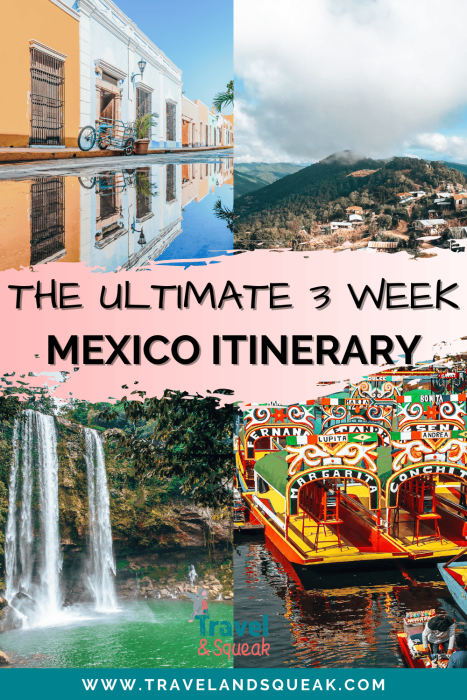
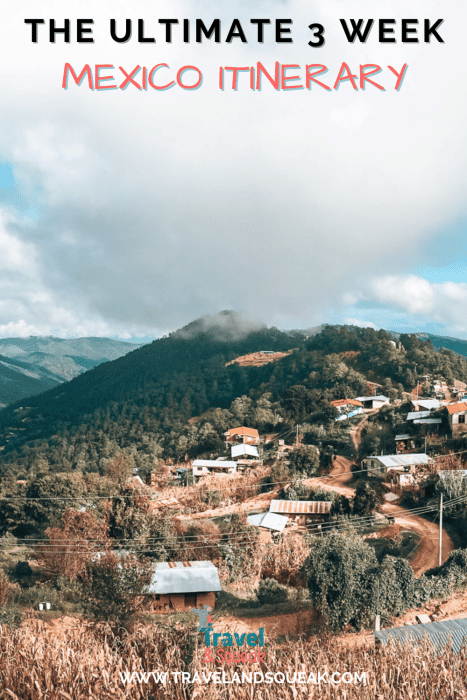
Contents
3-Week Mexico Itinerary
Mexico City
The first stop on your Mexico itinerary is 3 days in Mexico City; one of the oldest continuously inhabited cities in the Americas and one of my absolute favourite cities in the world!
Mexico City is buzzing with life and is a whirlwind of energy, culture, colour and history. Grand colonial buildings line bustling plazas perfect for people-watching, huge leafy parks offer a relaxing break from exploring the city, vibrant street art, world-class museums and delicious street food at every corner.
Exploring the Historic Centre is one of the best things to do in Mexico City. Centred around the massive Zocalo Plaza, the city’s beating heart is where you’ll find historic landmarks, iconic buildings, cathedrals, fascinating architecture, street vendors and a captivating, lively energy.

Visiting the Floating Gardens of Xochimilco, the Venice of Mexico, is another of the best things to do in Mexico City. This UNESCO World Heritage Site is made up of miles of waterways you explore on colourful trajineras (boats).
Cruise through canals passing other trajineras selling food and drink, locally-produced crafts and even mariachi bands playing on the water. It’s a really fun and unique experience. Keep an eye out for Isla de las Munecas, Island of the Dead Dolls, an eerie plot of land where dolls are hung from trees – fascinating and creepy all at the same time.

Other top things to do in Mexico City? Explore Chapultepec Forest, Latin America’s largest city park, learn about Mexico’s history at the Anthropology Museum, stroll around Parque Mexico, and a day trip to the spectacular ancient ruins of Teotihuacan is an absolute must!!
For everything you need to know about Mexico City, head to our guide below.
Oaxaca; beautiful places to visit in Mexico
3 days in Oaxaca is next on your Mexico itinerary. A firm favourite amongst visitors, Oaxaca is laidback, vibrant, full of character and oozes charm.
Colourful colonial streets, bustling markets, delicious food, fascinating architecture and spectacular natural scenery, Oaxaca is easy to fall in love with and hard to leave.
One of the best things to do in Oaxaca is to grab a drink in one of the cafes or restaurants in the Zocalo, the city’s main square. Soak up the atmosphere and watch the world go by. There’s always something going on – street vendors selling locally-produced crafts, kids playing, and friends and families socialising.
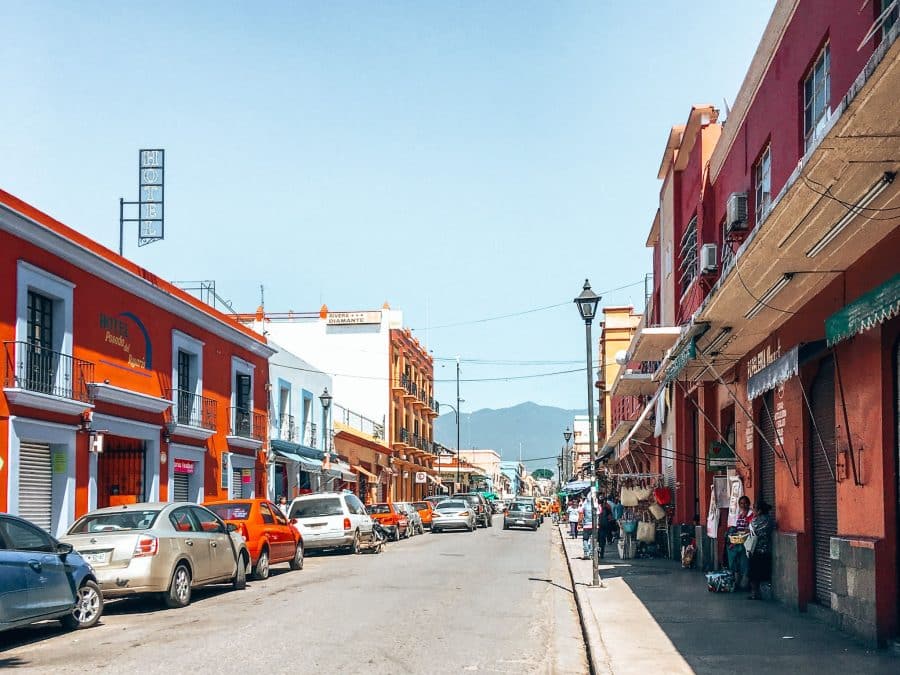
One of my favourite activities in Mexico was hiking in the Pueblos Mancomunados. Located in the Sierra Norte mountains, these are eight remote villages protected under a unique ecotourism project run by the local Zapotec communities.
Over 100 kilometres of scenic trails connect the villages, where you can discover a whole other side to Mexico. Waterfalls, canyons, caves and incredible vast viewpoints over the mountains. For the ultimate experience on your Mexico itinerary and a real local insight, stay in one of the villages overnight.

For more spectacular scenery around Oaxaca and one of the best places to visit in Mexico, head to Hierve el Agua. This natural wonder appears to be a frozen waterfall spilling over the cliffs into the valley below. You can also swim in some cliff-edge mineral pools while admiring the epic views over the mountains.

Other top things to do in Oaxaca are the Templo de Santo Domingo, the ancient Monte Alban ruins, souvenir shopping in the numerous colourful markets, mezcal tasting, and trying all the delicious Oaxacan cuisine.
Check out our complete guide to Oaxaca below for everything you need to know before you visit.
San Cristobal de las Casas
The next 3 days on your Mexico itinerary are spent in my absolute favourite city in Mexico, San Cristobal de las Casas. San Cristobal is the cultural heart of Mexico’s southernmost state, Chiapas; home to one of Mexico’s largest indigenous populations and scattered with dozens of traditional Tzotzil and Tzeltal villages.
San Cristobal beautifully fuses modern comforts and ancient traditions. This, combined with quaint colonial architecture, cobbled streets, colourful markets, and delicious food, makes it a wonderful base to explore the diverse landscapes of Chiapas.

San Cristobal sits in a small valley surrounded by green hills and pine forests. Situated at an altitude of 2,200 metres, it has a cool climate and the air is always clean and fresh.
The city is a must-visit on its own, but it’s also surrounded by jaw-dropping natural scenery – turquoise waterfalls, endless mountain vistas, imposing canyons, and forested lakes.
One of the best activities during your 3 weeks in Mexico is a boat trip on the Sumidero Canyon. This canyon is a geological fault formed millions of years ago and is considered to be one of the most spectacular places to visit in Mexico.
The walls reach whopping heights of 1200 metres and have some fascinating features. Keep your eyes peeled for spider monkeys and crocodiles!

For more incredible scenery, check out Lagunas de Montebello National Park; an area of almost 60 striking blue and turquoise lakes, a vast pine forest, a variety of wildlife, and impressive Mayan ruins.
Here, you can do some of the best activities in Mexico, from swimming in the lakes and hiking in the mountainous forest to even rafting to a cenote!
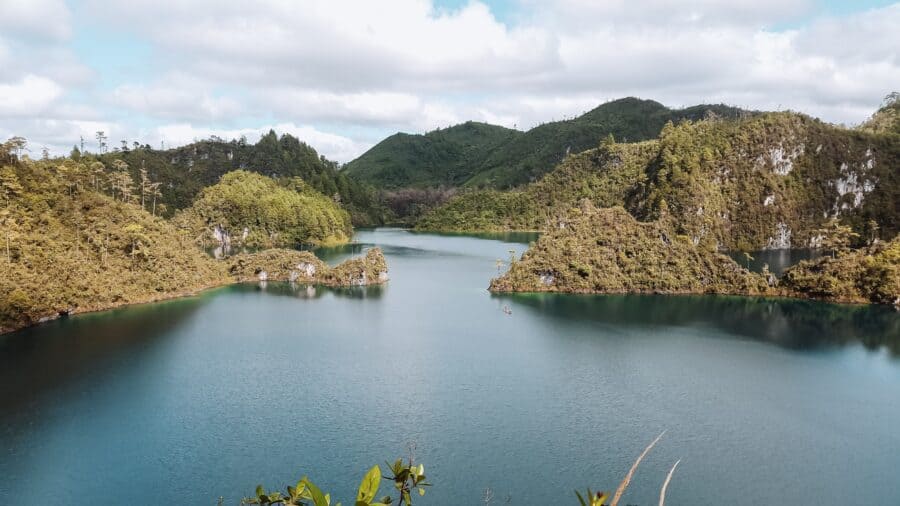
You can visit the ancient ruins of Palenque from San Cristobal on a day tour combined with Agua Azul and Misol-Ha waterfalls – two of the most spectacular places to visit in Mexico. It’s a very long day, so I’d recommend a night in Palenque if time allows, but if time is limited, this is an option.
Other top things to do in San Cristobal de las Casas are El Chiflon, five giant waterfalls tucked inside a beautiful valley, ambling the city’s picturesque streets, souvenir shopping in the markets, and for some gorgeous views across the city, climbing the stairs to Templo de Guadalupe.
Campeche; fascinating places to visit in Mexico
Next on your Mexico travel itinerary, Campeche for 3 nights. Another beautiful colonial city that’s largely managed to stay off the main tourist trail.
Exploring the historic old town is one of the best things to do in Campeche. Uniquely, Campeche’s old town has outer walls and fortifications as a result of the pirate attacks on the Caribbean port in the 17th and 18th centuries. You can still walk parts of the walls today for a different view of the rainbow-hued streets below.
Inside the walls, narrow cobbled streets are lined with pastel-coloured buildings, cute eateries and bars with outdoor seating – perfect for an afternoon drink or a spot to eat. And, thanks to the lack of tourism, prices remain low.

Just outside the walls is the malecón – a waterfront walkway. Visit just before sunset once the temperature has dropped and everyone comes to see the sunset, go for a stroll or run or socialise with friends. It’s such a peaceful way to end the day.

You can also rent a bike and explore the coast along the waterfront. Continue past the end of the walkway and you’ll reach Fuerte San Miguel, a hilltop fort with sweeping views across the ocean – another great spot for sunset.
The fort was built as a secondary protection against pirates and has a moat, drawbridge, and large stone walls. There’s also an archaeological museum containing many Mayan pieces of art and jewellery.

Other great things to do in Campeche include the Maya Architecture Museum, the pedestrianised street Calle 59, the light show on the square, and eating delicious seafood in one of the seafront restaurants.
Cancun
The next 3 days on your Mexico itinerary are a few days to unwind after being on the go.
Cancun is the party capital of Mexico, so if you’re craving a big night out, now’s your chance. Zona Hotelera is the main tourist area where most of the resorts and nightlife are.

However, there’s a lot more to Cancun than just bars and clubs.
Downtown Cancun gives you a taste of local culture with small boutiques, green parks, Mexican wrestling and street food vendors. It’s also very well connected, so you can experience the Zona Hotelera without having to stay there.
Without a doubt, one of the best activities in Mexico is relaxing on a gorgeous white sand beach, and the beaches in Cancun are some of the best beaches in Mexico. I 100% expected them to be overcrowded and dirty; however, I couldn’t have been more wrong!
Cancun has 21 kilometres of coast with soft white sand and turquoise waters. And, there’s a beach for everyone.
Craving a lively atmosphere and lots of bars and restaurants? Head to Playa Forum. If you’re looking for something laidback, where you can rent water sports equipment, then go to Chac Mool Beach. For somewhere quieter with no resorts/bars, Playa Delfines – one of the largest beaches in Cancun.

We definitely recommend venturing out of your resort and exploring further than the beaches – Cancun does have a lot to offer.
The UNESCO World Heritage Site, Chichen Itza, is easily visited in a day. This was one of the greatest Mayan centres of the Yucatan Peninsula and is one of the largest sacred sites in Mexico.
The Yucatan Peninsula is famous for cenotes – natural sinkholes formed by the collapse of limestone bedrock, exposing the crystal-clear groundwater underneath.
Mexico is littered with thousands of cenotes, and there are over 6000 in the Yucatan Peninsula alone, where you can swim, snorkel, and even scuba dive! Some of the best cenotes near Cancun are located along the Ruta de Cenotes (Cenote Route), and these are honestly some of the most incredible places to visit in Mexico.
Isla Mujeres; best beaches in Mexico
Just off the coast of Cancun is Isla Mujeres, where you’ll spend the next 3 days of your 3-week Mexico itinerary. This small, picturesque island is home to idyllic beaches, a colourful town centre, yoga classes, and tons of water sports.
The best way to explore the island is by golf cart. There are plenty of places you can rent one from, with prices starting from approximately US$23 per hour or US$50-$80 for the day. There’s one main road that travels around the island, so it’s impossible to get lost.
One of the highlights of Isla Mujeres is Playa Norte, one of the most beautiful beaches in Mexico. This long stretch of fine white sand lined with swaying palm trees is on the north of the island, and although it can get quite busy, it’s still worth a visit.

Temple Ixchel, honouring the Mayan goddess of happiness, fertility, and the moon, is a great spot to explore. The ruins are surrounded by art and rock sculptures, hidden cliffside beaches, and, if you’re lucky, you may even spot some iguanas.
One of the best things to do on Isla Mujeres is to visit the Cancun Underwater Museum. This museum is actually located on the seafloor! There are over 500 statues and structures created to promote coral life, and it’s an amazing place to scuba dive, snorkel or take a glass-bottom boat trip.
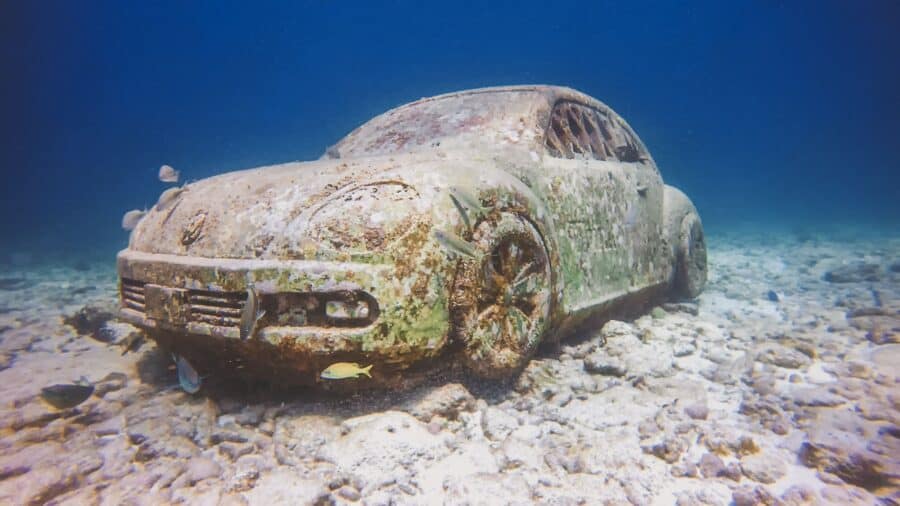
Other highlights of Isla Mujeres are: visiting Isla Contoy, a natural wildlife reserve and bird sanctuary, swimming with whale sharks, admiring the colourful street art and watching the magical sunsets.
Playa del Carmen
Next up is 3 days exploring Playa del Carmen, often viewed as Cancun’s little sister. While you’ll still find plenty of bars, restaurants and shops, it’s nowhere near the party vibes of Cancun.
As well as endless postcard-perfect beaches perfect for relaxing and soaking up the sun, Playa del Carmen is a great base for exploring more of the Yucatan’s treasures.
One of my favourite things to do on my Mexico itinerary was to swim in cenotes – a proper jungle adventure! There are different types of cenotes you can visit from Playa del Carmen, open, semi-open, cavern and ancient.
One of the most spectacular is Jardin del Eden, a large, open cenote set in a dense, lush jungle. The water’s crystal clear, so it’s ideal for swimming in. You can rent snorkels or even scuba dive to check out the fish and impressive underwater rock formations.

Cenote Chaak Tun is an underground cenote made up of three underground caves through which the Mayans entered their underworld, Xibalba. You can snorkel in the turquoise waters of the underground river surrounded by ancient stalagmites and stalactites. A completely unique experience and one of the best things to do in Mexico.
Other top things to do in Playa del Carmen are a day trip to Cozumel, a small island known for spectacular beaches and snorkelling, salsa dancing, watersports, and swimming with sea turtles in Akumal.
Bacalar
The final stop on your Mexico itinerary – 3 days in the super laidback Bacalar, one of Mexico’s Pueblos Mágicos (Magical Towns).
The Pueblos Mágicos initiative promotes rural towns recognised for their cultural, historical, natural beauty and/or architectural significance.
Bacalar is in Southeast Mexico, almost bordering Belize. It’s quite tricky to get to with no large hubs nearby, but 100% worth the trip. And, as it’s off the main path, you won’t see the crowds you did further up the coast.
The main draw is Bacalar Lagoon, unlike anywhere you’ve ever seen! It’s also called the Lagoon of Seven Colours, and as soon as you see it, you’ll get why. The lake shifts between different shades of blue depending on the depth and time of day. You’d be forgiven for thinking you were in the Caribbean Sea.
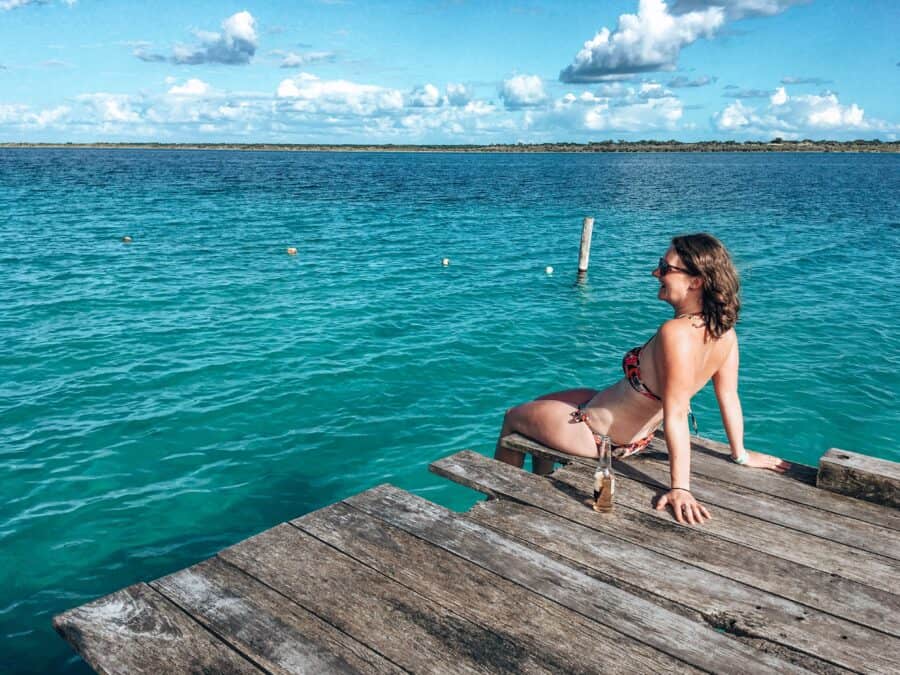
Bacalar Lagoon is Mexico’s second-largest body of water, measuring 43 kilometres in length and 2 kilometres wide at its widest point. The lagoon is actually a series of waterways fed by underground cenotes that lead to the Caribbean Sea and has an incredibly diverse ecosystem.
One of the top things to do in Bacalar and the best way to experience the lagoon is to rent a kayak or paddleboard and glide out on the water either at sunrise or sunset. Sunrise is super peaceful with fewer people around. However, sunset is still magical and the perfect way to end your day.

The beautifully clear, warm waters of Bacalar Lagoon are also an excellent place for a swim. However, to protect the ecosystem, you mustn’t wear any suncream so make sure you’ve got a cover-up you can wear in the water.
Some other great things to do in Bacalar are standup paddleboarding, sailing, snorkelling, swimming in cenotes, relaxing on one of the many docks around the lake, and exploring Fort San Felipe.
Everything You Need to Know For Your Mexico Travel Itinerary
The best time for your 3-week Mexico itinerary
In general, the driest months for any Mexico itinerary are December to April. Although this means the best weather, it also means more crowds and higher prices. I went in November – the weather was still a bit cooler, there were fewer tourists, and I only had a couple of rainy afternoons.
The rainy season runs from June to October, but the coast is affected the most. Central Mexico usually experiences heavy afternoon showers.
How to get around Mexico
I travelled this exact Mexico itinerary on buses. Buses in Mexico are very convenient, and if you’ve travelled on buses in places like Vietnam and Cambodia, you’ll find them seriously comfortable!
ADO buses are the most popular and offer different levels of luxury. I always travelled on the cheapest option (OCC) and the seats reclined, there’s plenty of legroom and also air-conditioning. If you’re travelling on a higher budget there’s GL class which offers more luxury and plush chairs.
If your budget allows, it may be worth some internal flights to save time. And, if you want complete freedom and flexibility, renting a car is a fantastic option!
Prices in Mexico
Mexico is extremely affordable, especially outside of the tourist hotspots and sticking to local food and drink. Street food meals can be as low as US$1, and domestic beer from US$2. Meals in restaurants can start at around US$8.
Dorms in hostels start from around US$10 a night, private rooms from US$18 and guesthouses from US$15 in less touristy areas. 4* and 5* hotels in the cities start from US$50 a night. If you’re keen on some all-inclusive luxury on your Mexico itinerary, you can get some fantastic deals starting from around US$150 a night for two people.
These prices vary by season and how popular the area is.
Do I need a visa?
As a UK passport holder, you don’t need a visa to visit Mexico as a tourist. You will need to fill in an immigration form online, and your passport must be valid for 180 days.
What currency do I need?
Mexico uses the peso. At the time of writing, 1 USD is 18.65 MXN
What plug do I need?
You’ll need either plug type A or B for your itinerary for Mexico. Both have two flat parallel pins, and B has a grounding pin.
I hope you’ve found this itinerary for Mexico useful in helping you plan your trip. Make sure to check out our other Mexico guides below, and if your Mexico itinerary is part of a larger Central America trip, head to our Guatemala and Belize posts.
Feel free to leave a comment or contact us if you have any other questions, and follow us on Instagram to stay up to date with us in real time.


